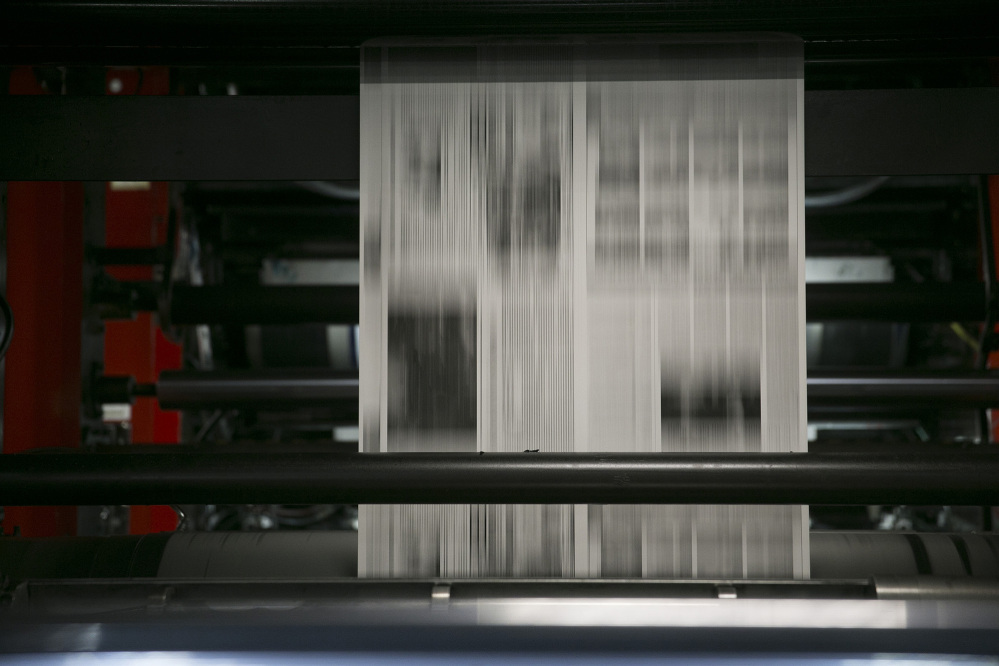If you’ve ever tried to fix a sweater by pulling out a stray piece of yarn, you have some idea of what can happen if you try to fix just one trade problem along the Canadian border.
You’ll quickly find that although the map says the nations are divided, the interests involved are knitted together, and if you try to pull them apart, you should expect to make a mess.
Witness charges of Canadian “dumping” of subsidized uncoated paper — newsprint — into American markets.
The loss of papermaking jobs in places like Maine is a real problem. But the proposed solution — a 30 percent tariff on imported paper that would be tacked onto the price paid by customers on this side of the border — creates problems of its own.
BAD POLICY
The customers are primarily newspapers and other publishers, companies already disrupted by the digital revolution, and they won’t be able to absorb a price hike like that without cutting expenses. In a labor-intensive business like ours, that means people.
So the government’s quest to save a few hundred paper mill jobs could end up wiping out thousands of newspaper jobs, illustrating how hard it is to translate slogans like “America First” into sensible trade policy.
We encourage Maine’s congressional delegation to get involved now and stop the U.S. Department of Commerce from making a serious mistake. The government is right to be concerned about the loss of manufacturing jobs, but using tariffs to help some companies keep a bigger piece of a shrinking market is the wrong fix.
The current complaint was filed by Norpac, a paper mill in Washington state, owned by the private equity fund One Rock Capital. It alleges that papermakers in Canada are getting a break on their energy costs and other assistance, making them unfair competitors for American mills.
Norpac wants the Commerce Department to slap a tariff on the Canadian imports, so they can get a shot at the business. So far, the members of the International Trade Commission agree, giving the idea preliminary approval.
That might be good news for Norpac and its 400 employees, but a 30 percent tariff added to the price of imported newsprint would be a serious blow to the American newspaper industry and the 180,000 people it employs.
American paper mills would not be able to meet the newspaper industry’s needs, so publishers would still be buying from the Canadian mills — at least until their counterparts in the U.S. started making more newsprint.
And there’s no guarantee the tariff would benefit American papermakers, because the decline of that industry, like the challenges we see in the newspaper business, is driven by forces beside foreign competition.
Because of the rise of the internet, demand for paper is down. And automation, both inside plants and in the forest, has resulted in job loss, even in highly productive and profitable mills. A tariff on Canadian paper won’t change those trends. In fact, it could even make them worse, because an inflated price for paper would further decrease demand, making less work for the industry as a whole.
TRENDS PERSIST
We know because we’ve seen this before. In 2015 — under President Barack Obama — a tariff was slapped on Canadian glossy paper, and Mainers celebrated, hopeful that it would keep the Madison Paper Industries mill in business.
It did not (the plant shut down last year), but it did set off a cascade of unintended consequences, hurting Maine workers employed by Canadian companies that have operations on both sides of the border.
The truth is that international trade doesn’t just ship jobs offshore, it also supports them at home. And protectionism doesn’t just save jobs, it can also make them disappear.
We need fair trade policy, but we also need smart trade policy, one that looks at indirect effects as well as immediate ones. A tariff on Canadian newsprint would create far more problems than it would fix.
Copy the Story LinkSend questions/comments to the editors.



Success. Please wait for the page to reload. If the page does not reload within 5 seconds, please refresh the page.
Enter your email and password to access comments.
Hi, to comment on stories you must . This profile is in addition to your subscription and website login.
Already have a commenting profile? .
Invalid username/password.
Please check your email to confirm and complete your registration.
Only subscribers are eligible to post comments. Please subscribe or login first for digital access. Here’s why.
Use the form below to reset your password. When you've submitted your account email, we will send an email with a reset code.